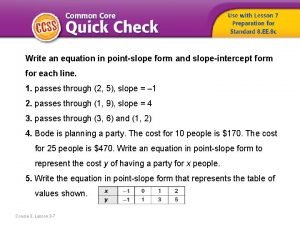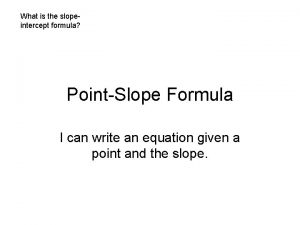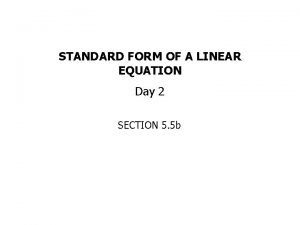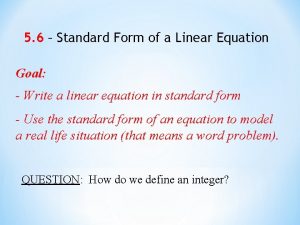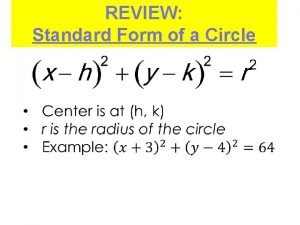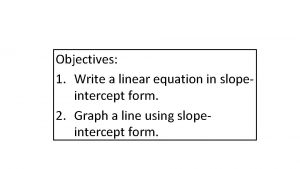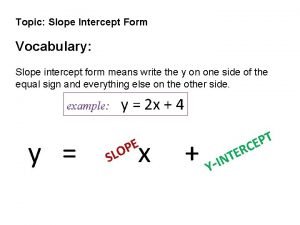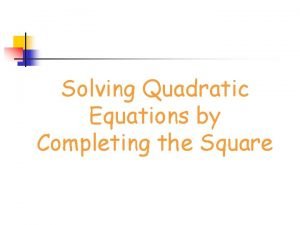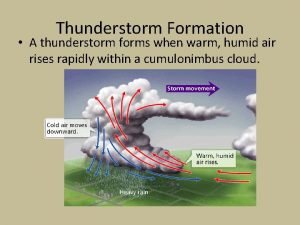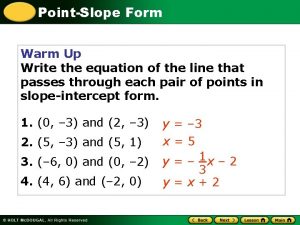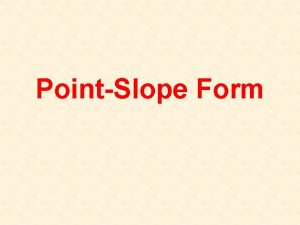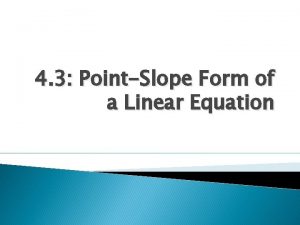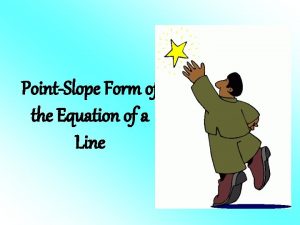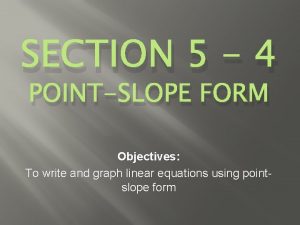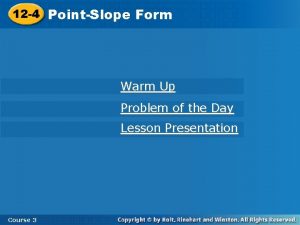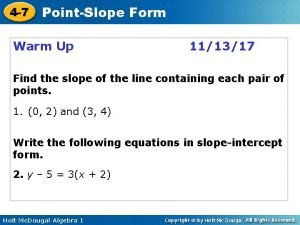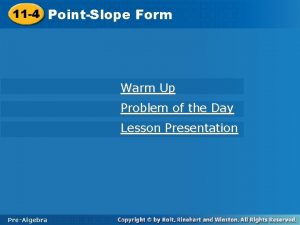PointSlope Form Warm Up Write the equation of

















- Slides: 17

Point-Slope Form Warm Up Write the equation of the line that passes through each pair of points in slope-intercept form. 1. (0, – 3) and (2, – 3) 2. (5, – 3) and (5, 1) 3. (– 6, 0) and (0, – 2) 4. (4, 6) and (– 2, 0) y = – 3 x=5 y = – 1 x – 2 3 y=x+2

Point-Slope Form

Point-Slope Form Pg. 221

Point-Slope Form The point-slope form of an equation of a line with slope m passing through (x 1, y 1) is y – y 1 = m(x – x 1). Point on the line (x 1 , y 1 ) Point-slope form y – y 1 = m ( x – x 1) slope

Point-Slope Form video

Point-Slope Form Additional Example 1 A: Using Point-Slope Form to Identify Information About a Line Use the point-slope form of each equation to identify a point the line passes through and the slope of the line. y – 7 = 3(x – 4) y – y 1 = m(x – x 1) The equation is in point-slope y – 7 = 3(x – 4) form. Read the value of m from the m=3 equation. (x 1, y 1) = (4, 7) Read the point from the equation. The line defined by y – 7 = 3(x – 4) has slope 3, and passes through the point (4, 7).

Point-Slope Form Additional Example 1 B: Using Point-Slope Form to Identify Information About a Line y– 1=1 3(x + 6) y – y 1 = m(x – x 1) y – 1 = 1 (x + 6) 3 Rewrite using subtraction y – 1 =1 [x – (– 6)] 3 instead of addition. m =1 3 (x 1, y 1) = (– 6, 1) The line defined by y – 1 = 1 (x + 6) has slope 1 , and 3 3 passes through the point (– 6, 1).

Point-Slope Form Check It Out: Example 1 A Use the point-slope form of each equation to identify a point the line passes through and the slope of the line. y – 5 = 2 (x – 2) y – y 1 = m(x – x 1) y – 5 = 2(x – 2) The equation is in point-slope form. Read the value of m from the m=2 equation. (x 1, y 1) = (2, 5) Read the point from the equation. The line defined by y – 5 = 2(x – 2) has slope 2, and passes through the point (2, 5).

Point-Slope Form Check It Out: Example 1 B 2 y – 2 = 3(x + 3) y – y 1 = m(x – x 1) y – 2 = 2 (x + 3) 3 y – 2 = 2 [x – (– 3)] 3 m =2 3 (x 1, y 1) = (– 3, 2) Rewrite using subtraction instead of addition. The line defined by y – 2 = 2 (x + 3) has slope 2 , and 3 3 passes through the point (– 3, 2).

Point-Slope Form Additional Example 2 A: Writing the Point-Slope Form of an Equation Write the point-slope form of the equation with the given slope that passes through the indicated point. the line with slope 4 passing through (5, – 2) y – y 1 = m(x – x 1) [y – (– 2)] = 4(x – 5) y + 2 = 4(x – 5) Substitute 5 for x 1, – 2 for y 1, and 4 for m. The equation of the line with slope 4 that passes through (5, – 2) in point-slope form is y + 2 = 4(x – 5).

Point-Slope Form Additional Example 2 B: Writing the Point-Slope Form of an Equation the line with slope – 5 passing through (– 3, 7) y – y 1 = m(x – x 1) y – 7 = -5[x – (– 3)] Substitute – 3 for x 1, 7 for y 1, and – 5 for m. y – 7 = – 5(x + 3) The equation of the line with slope – 5 that passes through (– 3, 7) in point-slope form is y – 7 = – 5(x + 3).

Point-Slope Form Check It Out: Example 2 A Write the point-slope form of the equation with the given slope that passes through the indicated point. the line with slope 2 passing through (2, – 2) y – y 1 = m(x – x 1) [y – (– 2)] = 2(x – 2) y + 2 = 2(x – 2) Substitute 2 for x 1, – 2 for y 1, and 2 for m. The equation of the line with slope 2 that passes through (2, – 2) in point-slope form is y + 2 = 2(x – 2).

Point-Slope Form Check It Out: Example 2 B the line with slope – 4 passing through (– 2, 5) y – y 1 = m(x – x 1) y – 5 = – 4[x – (– 2)] Substitute – 2 for x 1, 5 for y 1, and – 4 for m. y – 5 = – 4(x + 2) The equation of the line with slope – 4 that passes through (– 2, 5) in point-slope form is y – 5 = – 4(x + 2).

Point-Slope Form Additional Example 3: Entertainment Application A roller coaster starts by ascending 20 feet for every 30 feet it moves forward. The coaster starts at a point 18 feet above the ground. Write the equation of the line that the roller coaster travels along in point-slope form, and use it to determine the height of the coaster after traveling 150 feet forward. Assume that the roller coaster travels in a straight line for the first 150 feet. As x increases by 30, y increases by 20, so the slope 2 of the line is 20 or. The line passes through the 30 3 point (0, 18).

Point-Slope Form Additional Example 3 Continued y – y 1 = m(x – x 1) Substitute 0 for x 1, 18 for y 1, y – 18 = 2 (x – 0) 3 and 2 for m. 3 The equation of the line the roller coaster travels along, in point-slope form, is y – 18 = 2 x. Substitute 150 for x 3 to find the value of y. y – 18 = 2 (150) 3 y – 18 = 100 y = 118 The value of y is 118, so the roller coaster will be at a height of 118 feet after traveling 150 feet forward.

Point-Slope Form

Point-Slope Form
 Course 3 point-slope form answer key
Course 3 point-slope form answer key Pointslope form
Pointslope form Pointslope formula
Pointslope formula Quadratic formula round to the nearest hundredth calculator
Quadratic formula round to the nearest hundredth calculator How to write equation in standard form
How to write equation in standard form How to write and equation in slope intercept form
How to write and equation in slope intercept form Slope intercept example
Slope intercept example Forms of linear equations
Forms of linear equations How to write equation in standard form
How to write equation in standard form How to write a slope intercept equation
How to write a slope intercept equation Writing and graphing equations in two variables
Writing and graphing equations in two variables General form of a circle to standard form
General form of a circle to standard form Linear equation graphs worksheet
Linear equation graphs worksheet How to write an equation in slope intercept form
How to write an equation in slope intercept form Complete the swuare formula
Complete the swuare formula What is displacement current
What is displacement current Equation of a circle general form to standard form
Equation of a circle general form to standard form Thunderstorms form when warm humid air rises in a(n)
Thunderstorms form when warm humid air rises in a(n)
